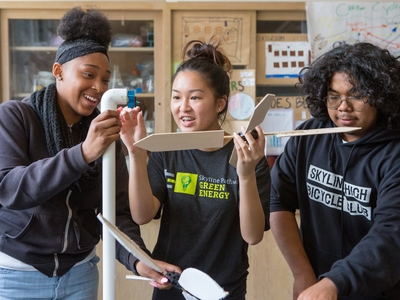New Designs for School
Upgrading School Operating Systems with 3 Modern Strategies
Topics

We’ve all had the experience of truly purposeful, authentic learning and know how valuable it is. Educators are taking the best of what we know about learning, student support, effective instruction, and interpersonal skill-building to completely reimagine schools so that students experience that kind of purposeful learning all day, every day.
Three Core Principles for Learning Environments that Serve All Students
What is the most important thing that your computer does? Email? Word processing? Video streaming?
Each of these functions provides a lot of value. But I’d argue that the most important thing a computer does is more basic: it operates. Beneath the displays we see and the programs we run is a sophisticated operating system, which coordinates the various processes required to send a message, create a presentation, or watch a movie. Without the operating system, nothing else would be possible.
A classroom, I think, is like a computer: it’s an environment in which many complex processes are constantly occurring. Not only are teachers simply delivering content, they are trying to provide each student with the academic, social, and emotional supports that each learner needs. Students, meanwhile, are not only sitting and listening, they are interacting with course materials and with each other, not to mention all the other things that might catch their attention. At any moment, there are literally hundreds of things happening.
How do teachers manage all of this? Whether implicit or explicit, each classroom has an operating system of its own—a set of rules and protocols that govern the behavior of each individual component. It’s why teachers spend so much time each year reviewing expectations and procedures, and why each of us acts the way we do when we enter a classroom. The way the classroom functions determines whether and how students will learn.
What our young people need, in fact, is a new operating system—one that facilitates high-quality interaction, lets students set the pace, and emphasizes mastery.
In the same way that engineers seek to optimize the operating systems in our phones and computers to maximize what these devices can do, educators must seek to optimize the conditions for learning that exist in their classrooms, to maximize the learning that each student can achieve. The traditional teacher-centered, lecture-style model is one possible operating system—and one that maximizes efficiency of instruction—but is it the best for student learning? At The Modern Classrooms Project, we believe that there are a few core principles that any classroom operating system should follow:
1. High-Quality Interactions Enhance Learning.
At some point in our lives, all of us have needed help from someone in understanding something. In general, that help is most useful when it is targeted to our unique needs, is delivered in a way that we can access, and responds directly to our questions and misconceptions. Learning is hard—but these high-quality interactions with experts helps us master things we initially thought were too hard.
Schools around the country are filled with caring educators who want nothing more than to have this sort of interaction with their students. Yet the lecture model of learning means that most interactions between teachers and students are of a relatively low quality: the teacher speaks and manages behavior while the students are expected to sit quietly and listen. Students may be intimidated to ask the teacher questions, and they are unable to speak to each other while the teacher instructs. It’s often only after the lecture that these meaningful conversations can occur…if there’s any time remaining.
In Modern Classrooms, on the other hand, teachers replace their lectures with instructional videos that they create themselves and that students watch in class or at home. This frees the teacher up to spend class time engaging directly with students and allows students to collaborate with each other throughout class. Both the number and quality of interpersonal interactions increase dramatically.
2. Students Learn Best at Their Own Paces.
We all know from experience that, starting from infancy, different people master different skills at different rates. Some children walk at eight months; others take twice as long. As we know, that’s just part of life. We also know how stressful it can be to feel that one is “behind” when it comes to learning something important.
The Montessori method, and other learner-centered methods of pedagogy which are most commonly found in elementary settings, recognize and celebrate the diversity that exists among learners. Yet as students get older, they’re often forced into tightly regimented courses that allow for little to no variation in pacing. Students who need more time have little chance to catch up, while students who learn quickly have little opportunity to advance. It makes school stressful for some, boring for others, and stifling for all.
In Modern Classrooms, however, teachers empower students to learn at their own paces, with the aid of instructional videos, within each unit of study. Falling behind is no longer cause for panic—students just need to work to catch up. Meanwhile, getting ahead no longer means wasted time in class—the next lesson is always ready. Class time becomes not only more productive for each individual student, it becomes more enjoyable, too.
3. Mastery Is Essential.
Have you ever tried to have a conversation in a foreign language without first learning how to say hello? It makes no sense. To acquire advanced knowledge and skills, in a foreign language or in anything else, requires fundamental skills to be in place first.
The impediment to learning in most classrooms is not insufficient curriculum, lax standards, nor student laziness. There are tons of great lessons out there, state standards are often highly rigorous, and students are as capable as ever. The problem is that students aren’t always prepared to access the content they’re given: the traditional age-based system of education moves students along from class to class regardless of whether or not they’ve actually mastered the skills they’ll need to succeed. It should come as no surprise that students struggle in Algebra 2 when they earned a D in Algebra 1!
Most Modern Classrooms exist within the same aged-based constraints—but teachers emphasize mastery in two ways: by giving their students credit for assignments only once those students show mastery and by giving students who fall short ample opportunities for revision, reassessment, and reflection. Students learn, over time, that what matters is not simply handing assignments in but instead really learning what each assignment is meant to instill. It’s a lesson that will serve them well.
As a teacher who follows education closely, I know that the elements for great education already exist in most schools: caring teachers, good curricula, and students who want to learn. Replacing educators or changing curriculum won’t make the transformative change those students need, so long as the larger structures that hold students back remain in place in the educational operating system.
What our young people need, in fact, is a new operating system—one that facilitates high-quality interaction, lets students set the pace, and emphasizes mastery. Once that’s in place, there’s no limit to what our young people can achieve.
Photo by Devon Janse van Rensburg




